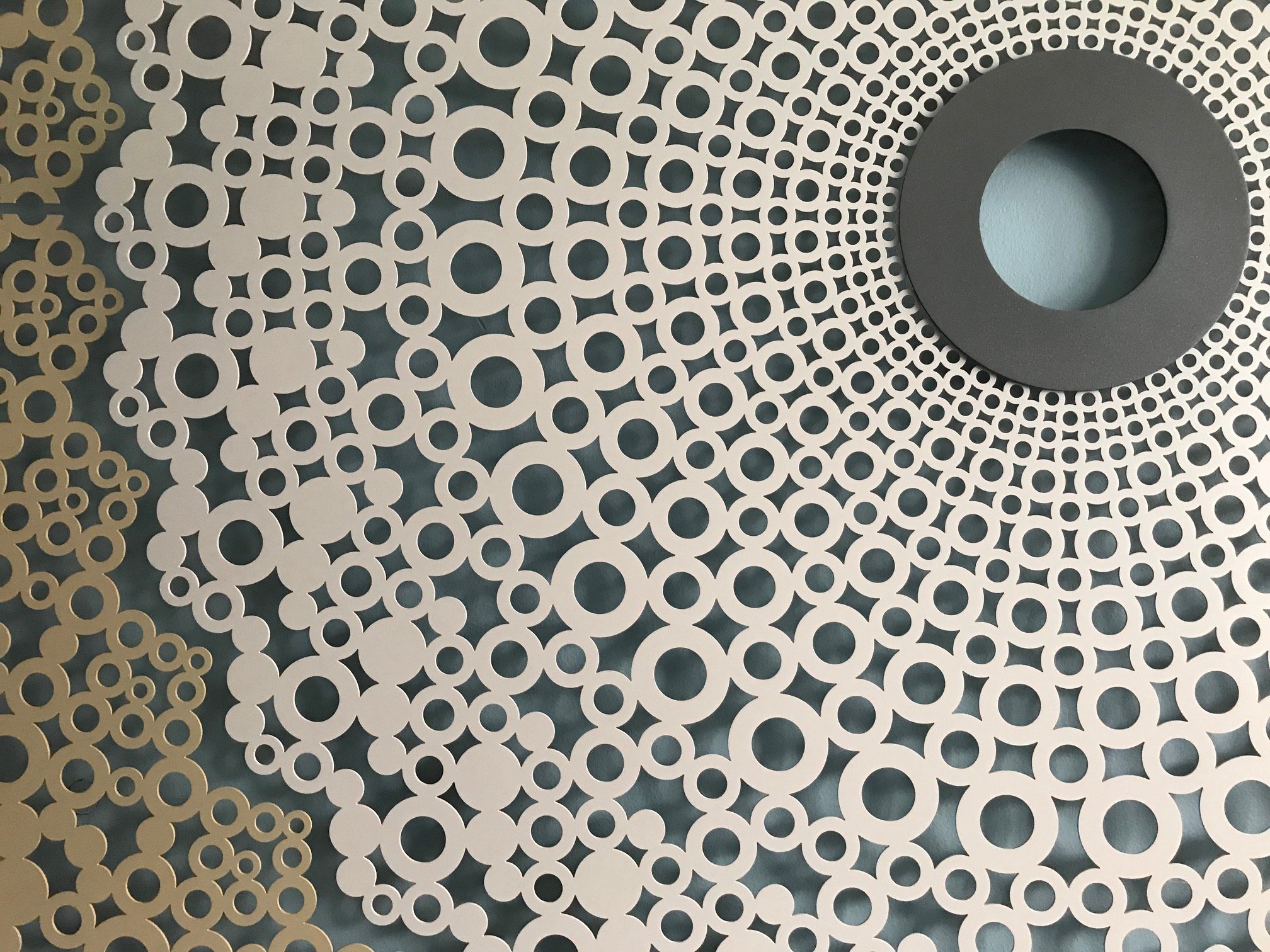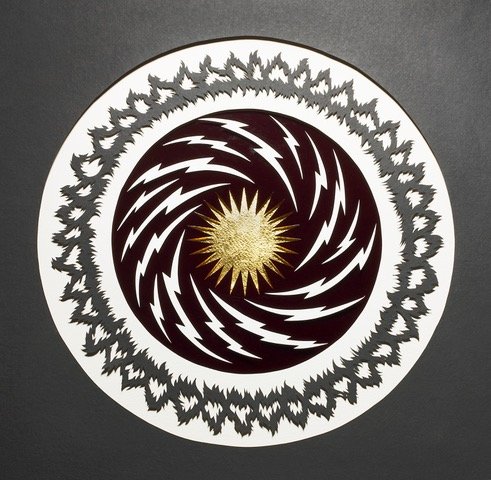Transferable creativity: Taking a leap to see where you land
The works that craftspeople are known for often represents just one element of a creative output that spans a multitude of techniques, practices and materials. For Goldsmiths’ Stories, Janice Hosegood, meets four of the makers who are creatively taking a leap to see where they land.
At some point, jewellers and silversmiths must all decide to make creativity their career. They’ve taken the leap to study at great length, master skills and techniques, alongside embracing the mechanisms to run a successful business. The talent and originality amongst them is clear for all to see but as individuals, that creativity doesn’t stop with the work that we’re most familiar with.
Acclaimed jeweller, silversmith and master engraver Alan Craxford, speaks openly about the balance between his physical health and the need to be at his workbench. His studio sits within his well-tended garden and is just a short walk from his living room but several years ago, this journey became impossible for quite some time.
He’d undergone some essential but complicated surgery on his foot and was under strict orders not to move. “What do you do when you can’t do what you normally do?,” he voiced in relating the story to me. His inclination was to reach for his sketchbook and pen, as a natural part of his design process. “I often find ideas come in a simple form to start with, so I always spend time exploring” he explains. Then a brainwave occurred. He swapped his pen for a scalpel and began to experiment with cutting fine lines into watercolour paper.
Using the same precision that he’s known for with his jeweller’s tools, Alan began deftly cutting away shapes, creating positives and negatives where paper was removed. “It felt different to using precious metal” he says, “I wasn’t risking something valuable so had more freedom with my experiments.” This freedom enabled him to be quite prolific and he began producing finished artworks and framing them. The first of these bear close resemblance to his jewellery, recognisable from his decorative engraving but as he continued, he realised that the important element in these works is the light; the shadows and the layers and how they change depending on your viewpoint.
Returning to his jewellery studio sometime later once his mobility improved, it was only natural that he wanted to use this new vocabulary of layering light and shadow. Even though he’d explored the optical effects possible with foiled paper, he was only able to realise its full potential with the high level of reflection achievable with metal.
For me, there’s a clear ‘before’ and ‘after’ papercutting in Alan’s jewellery and I’m delighted to see that he continues to work on both forms. He’s exhibited the paperwork alongside his jewellery in the past and had a solo show with his paperwork and his photography in recent years, and they’ve clearly become a permanent part of his creative practice.
Sarah Stafford’s jewellery is admired for its detail and precision. She uses traditional skills combined with state-of-the-art 3-D modelling that allow the creation of geometric structures in precious materials. Plant cells, microbiology and geometry all play a part in the development and design of her work with the themes of repetition and how the most insignificant parts can create complex, strong, balanced forms.
Sarah’s first opportunity to apply her concepts to a different form came about with a commission from corporate art-curator Tom Tempest-Radford. He’d clearly seen possibilities in Sarah’s jewellery which gave her the chance to transform her work to a new level. This brought her into the realm of large-scale architectural metalwork and installations. The culmination of this first project is 22 large artworks now hanging in the Peninsular Restaurant aboard P&O’s flagship liner Britannia.
Always having the confidence to follow suggestions from friends and colleagues, Sarah went on to explain about the evolution of her art prints: “They came about a couple of years ago after discussions with a friend about how much he liked the working drawings for the wall panels on my computer screen.” Their dialogue continued and the idea formed to try printing them. “The first ones worked beautifully on the screen but transferred badly onto paper” Sarah said, “there was a lot of colour because of the layers in my digital files and they were just too busy.”
Comfortable with admitting that she’s not a colourist and works better with a limited palette, Sarah explored the possibilities of using these computer-generated images, simplifying them in terms of colour but pushing them beyond their function of being working drawings. “Each one is based on the vector line used to cut a specific wall panel” she explains, “and that line is distorted using various commands and parameters until I’m generating a balanced composition.” They clearly represent what appears to be the antithesis of what she does: ordered, meticulously made, geometric pieces, but even in the levels of distortion she’s creating, you can still see the ghost of what the lines originally were.
“I need order” Sarah confesses, “and definitely have obsessive-compulsive tendencies, but I’m also drawn to organic forms, which doesn’t come natural to me when I make. This is my way of achieving this.”
At first glance, Sarah Warsop’s jewellery is a complex puzzle. You have to spend time looking at the soft twists and turns that she forges into silver and gold. Trace the wires with your fingers and it starts to make sense. Put it on and feel how it settles on your finger or against your neck.
That understanding of how a piece has to balance and sit on the body is a skill that every accomplished jeweller possesses but for Sarah Warsop, it’s at the heart of her working process and her concepts.
Sarah is a jeweller and choreographer. She has danced professionally for over 25 years with Rambert Dance company and Siobhan Davies Dance before completing an MA at St Martins in Jewellery. But Sarah is also a skilled artist and I wanted to explore the connections. “The bridges between dance, movement and drawing are my routes to understanding how to translate my ideas in jewellery,” Sarah explains.
And music is clearly her muse: “My drawings, paintings and precious metal jewellery begin with a chosen sound, piece of music or choreographed movement. The drawing and mark making is my physical response to effort, rhythm and tempo. I use the time span and the dynamic of a movement phrase or sound score to suggest the scale of my drawings and how long they take to do. The energetic lines and colour layering are created with charcoal, graphite, powder pigments and most recently acrylic paints.”
Now segmented and framed in sections, Sarah’s largest work was a collaboration with artist Tracey Rowledge, commissioned by Siobhan Davies Studios in 2011: ‘What isn’t here hasn’t happened’. It’s a series of graphite drawings exploring mark-making through choreographed movement, with most of the artworks measuring at least two metres wide.
One of my own favourites is a large wall piece ‘And I’ll dance with you’, created over a weekend in a corridor at Cockpit Arts where Sarah has her studio. Her musical muse for this work being Max Richter’s Recomposed from Vivaldi’s Four Seasons.
“I find painting and mark making to be a more immediate, emotional and physical response for exploring ideas” Sarah explains of its place in her process: “and as an example, I used the choreography from the work with Tracey Rowledge to develop the Whisk jewellery collection.”
Just as Sarah so deftly veers between differing scales, it’s also a quality that fails to daunt Marianne Forrest. Known for many years as a maker of timepieces, it was clear her ideas were transferable from the tiniest of wristwatches to huge architectural installations for urban spaces. “I trained in fine metalwork so I could bring my skills to each artwork from the smallest gold watch to massive sculptures for sites as varied as shopping malls and cultural centres” she says of her long-standing practice.
Marianne has always utilised digital design technology when planning all her pieces and this has enabled her to be comfortable with scale. “It’s easy to envisage a watch on my wrist as I’m working on a commission, for example” she explains, “but my computer screen makes it just as accessible to understand how my public art pieces work in very specific locations.”
A career decision to commit herself to full-time teaching in 2016, along with nowhere to place her workbench in a new home, meant that Marianne left behind the world of making apart from the occasional commission. She’s now the Head of 3D at London Metropolitan University and is passionate about the importance of her role as a tutor. “It was a metamorphosis of my creativity” Marianne tells me, “ and it gave me the unforeseen outlet of exploring creative practice as a collaborative experience.”
Throughout her years as a maker, Marianne had continually examined the idea of time through processes used in drawing. There’s a considered connection between physical markers of time in her watches to the large-scale drawings that have immerged recently. The opportunity to work towards an exhibition in 2018 at Birmingham’s Vittoria Street Gallery gave Marianne the chance to explore these concepts more fully.
Although ‘Acts of Resistance’ was a solo show, Marianne’s development encompassed drawing as a collective. Her huge drawings were created with the help of others, working together on one canvas as a team, leaving behind the evidence of their coming together for a moment in time. The works are attributed but simultaneously anonymous as each mark merges with that of the next leaving behind traces of time well spent.
Displayed the following year in London Met University’s Atrium Gallery, this body of work continues to evolve for Marianne and informs her more in-depth academic research and teaching principles. One of the most powerful pedagogical examples being where students and teachers produce work and learning together; where the teacher becomes more of a mentor or coach helping students achieve the learning goal.
In a quest to conclude after sharing these four examples, I was led to try to define creativity. That’s an impossible foray, of course, into an area of great research and learned essays but one quote from American poet Mason Cooley stood out: “Creativity makes a leap, then looks to see where it is.”
I’m not altogether certain that Alan, Sarah, Sarah and Marianne are consciously leaping but because of how they’re hard-wired, their creativity is all about seeing things differently: “Creatives see opportunities in problems” Debrah Tonro said at the ‘What is creativity for in the UK today?’ conference in 2019, “and are very skilled at shifting a lens and finding new ideas in the familiar.”
Written by Janice Hosegood | Photography Paul Read, Sarah Stafford, Alan Craxford, Sarah Warsop, Marianne Forest













